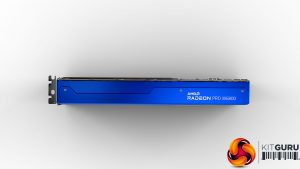The Radeon Pro W6800 maintains the familiar blue appearance of recent Radeon Pros, with the silver strip down the middle showing the model and branding. This is a hefty dual-slot card, with a reassuringly solid build and decently sized fan, although just a single one.
The W6800 benefits from PCI Express 4.0, although Ampere-generation NVIDIA Quadro RTX cards also support this. Although the W6800 has the same number of Stream Processors (3,840) as the Radeon RX 6800, they are clocked at a higher frequency – 2,075MHz base with a 2,320MHz boost, compared to 1,700MHz with a 2,105MHz boost for the RX 6800. This enables the W6800 to deliver 17.83TFLOPS of single precision compute, compared to 16.17TFLOPS for the RX 6800.
The memory performance is identical, however, albeit the amount supplied twice as much. The bus is 256-bit and the GDDR6 runs at 2,000MHz octo-pumped to 16,000MHz, delivering 512GB/sec. This is more than NVIDIA's latest Quadro RTX A4000 (448GB/sec), but the A5000 and A6000 have more bandwidth (768GB/sec). The AMD Radeon Pro W5700 also delivers 448GB/sec memory bandwidth, so the W6800 beats that, as well as sporting 67 per cent more Stream Processors operating at a faster clock. It should be a much faster card than the W5700.
The AMD Radeon Pro W6800 is so new that TechPowerUp GPU-Z doesn't recognise it properly. However, it correctly detects the 3,840 Stream Processors, PCI Express 4.0 bus and 256-bit memory bus.
With such a huge amount of memory on board, you would expect the W6800 to support very large monitor resolutions. Like the W5700, Mini-DisplayPort connections are employed to enable six of them in a row. Each of these can support displays up to 5K at 60Hz, so you could create a six-monitor wall 15K across and two screens high. Two 8K (7,680 x 4,320) screens can be supported at once, too. All the Mini-DisplayPort connections are 1.4 level.
All the usual acceleration APIs are supported, including OpenCL 2.1, OpenGL 4.6, Vulkan 1.2 and DirectX 12 Ultimate. The latter adds DirectX Raytracing 1.1, which the W6800 accelerates in hardware, alongside Variable Rate Shading, Mesh Shaders and Sampler Feedback.
The W6800 requires both eight-pin and six-pin power connections, with a peak draw of 250W. That is less than the NVIDIA Quadro RTX 5000, which peaks at 265W, but the A5000 has dropped this to 230W. Still, this is not a power-hungry card considering its capabilities. It is clearly a major upgrade over the AMD Radeon Pro W5700, and any other mainstream professional card AMD has produced so far.
 KitGuru KitGuru.net – Tech News | Hardware News | Hardware Reviews | IOS | Mobile | Gaming | Graphics Cards
KitGuru KitGuru.net – Tech News | Hardware News | Hardware Reviews | IOS | Mobile | Gaming | Graphics Cards







